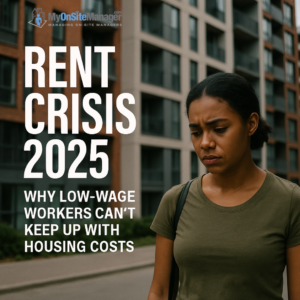Renting a home in the United States has become increasingly out of reach for millions of low-wage workers. According to the National Low Income Housing Coalition’s (NLIHC) “Out of Reach 2025” report, the average minimum-wage worker would need to work 116 hours a week nearly three full-time jobs to afford a modest two-bedroom apartment without being considered cost-burdened.
The problem isn’t just a result of stagnant wages. Rents have surged across the country, while wages, particularly for low-income workers, have failed to keep pace. This growing disparity is driving financial instability, housing insecurity, and widening inequality.
The Concept of a Housing Wage
The “housing wage” is the hourly income a full-time worker must earn to afford rent and utilities without spending more than 30% of their income a standard metric for affordability.
-
2025 Housing Wage:
-
$33.63 per hour for a modest two-bedroom apartment.
-
$28.17 per hour for a one-bedroom unit.
-
By comparison, the federal minimum wage remains stuck at $7.25/hour, and even in states with higher minimums, none come close to meeting the required housing wage.
Regional Rent Gaps
Some states illustrate just how wide the gap has become:
-
California: Requires a staggering $49.61/hour for a two-bedroom unit.
-
New York: Workers need $46.03/hour for similar housing.
-
West Virginia (lowest housing wage): Still requires $18.94/hour, far above the federal minimum wage.
This means even workers in the least expensive states often need two to three jobs to avoid being crushed by rent.
The Numbers Behind the Crisis
-
The average U.S. renter earns $23.60/hour, which is nearly $10 less than needed for a two-bedroom apartment.
-
There are just 219 counties nationwide where a minimum-wage worker can afford a one-bedroom unit without being cost-burdened.
-
49 states fail to meet the housing wage for two-bedroom rentals with average renter earnings, and 37 states can’t meet the standard for a one-bedroom.
The Ripple Effects of Unaffordable Rent
The rent crisis has far-reaching implications:
-
Cost-Burdened Households: Nearly 50% of U.S. renters are cost-burdened, spending more than 30% of their income on housing.
-
Severe Burdens: More than a quarter spend over 50% of their income on rent, leaving little room for necessities like food, healthcare, and transportation.
-
Eviction and Homelessness Risks: As rents continue to outpace wages, eviction rates rise, leading to an increase in homelessness and housing insecurity.
-
Declining Quality of Life: Families often compromise on living conditions, moving into smaller, overcrowded, or unsafe units just to save money.
Why Are Rents So High?
Several factors are driving the unaffordability crisis:
-
Lack of affordable housing supply: Developers often prioritize luxury apartments due to higher profits, leaving fewer affordable units available.
-
Wage stagnation: While housing costs have skyrocketed over the last decade, wage growth for low- and middle-income earners has been minimal.
-
Inflation and rising costs: Utilities, maintenance, and property taxes have all increased, leading landlords to raise rents.
-
Post-pandemic shifts: Remote work and migration patterns have driven up demand in some regions, further increasing rents.
Proposed Solutions
Addressing the rent crisis requires systemic reforms and long-term strategies, including:
-
Raising Wages: Updating federal and state minimum wages to better align with housing costs.
-
Expanding Affordable Housing: Greater investment in low-income housing programs and incentives for developers to build affordable units.
-
Rental Assistance Programs: Expanding Section 8 vouchers and emergency rental assistance.
-
Tenant Protections: Implementing stronger rent control policies and eviction protections to prevent displacement.
-
Tax Incentives: Providing tax breaks for landlords who keep rents at affordable levels or offer long-term leases to low-income tenants.
The Human Toll of the Crisis
Beyond the statistics, this issue impacts real people families working multiple jobs who still can’t afford a safe, stable home. The constant stress of juggling bills, rent, and basic needs can lead to physical and mental health challenges, affecting entire communities.
Conclusion
The “Out of Reach 2025” report underscores a harsh reality: the American dream of safe and affordable housing is slipping away for millions of low-wage workers. Without bold action through wage increases, housing investments, and stronger protections this crisis will only deepen.
Source:
Rent Remains Unaffordable for Low-Wage Workers – Housing Finance

